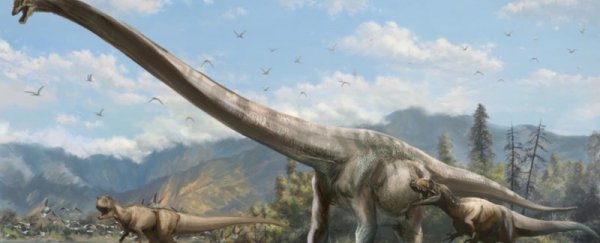The myth of the dragon that began in ancient China was very likely inspired by the inadvertent discovery of dinosaur fossils.
But perhaps it took a super-sized dinosaur skeleton - with a freakishly long neck - to really get the myth kick-started.
This is the suggestion of a team of palaeontologists from the University of Alberta in Canada, who recently discovered a new species of sauropod dinosaur whose enormously long neck (7.5-metres-long) was half the length of its body.
The fossil was uncovered by construction workers in 2006 at a build site near Quijiang City in southern China. It included a large neck vertebra, and importantly, the head was still attached, which researchers said was quite rare.
The dinosaur has since been named Qijianglong, which translates to "Dragon of Qijiang."
"China is home to the ancient myths of dragons," said PhD student Tetsuto Miyashita in a statement . "I wonder if the ancient Chinese stumbled upon a skeleton of a long-necked dinosaur like Qijianglong and pictured that mythical creature."
Most sauropod dinosaurs had necks that were about one-third the length of their body, but a select few belonging to the Mamenchisauridae family had necks that could grow up to half their body's length.
Interestingly, all of these dinosaurs have been found in Asia.
"It is still a mystery why Mamenchisaurids did not migrate to other continents," said Miyashita in the press release. "It is possible that the dinosaurs were once isolated as a result of a large barrier such as a sea, and lost in competition with invading species when the land connection was restored later."
Qijianglong was a herbivore that lived about 160 million years ago in the Late Jurassic period and was about 15-metres-long. (As a reference point, an average city bus is about 12-metres-long).
Of course, having a 7.5-metre-long neck could cause certain issues with balance and mobility.
The researchers say the dinosaur was able to avoid being too top-heavy due to an evolutionary feature whereby its vertebrae "were filled with air, making their necks relatively lightweight."
But their mobility would have still been limited.
According to the press release, the dinosaur had interlocking joints between the vertebrae, which "indicate a surprisingly stiff neck that was much more mobile bending vertically than sideways, similar to a construction crane."
The University of Alberta team has described its newly discovered species in a paper published in the Journal of Vertebrate Paleontology.
Source: CBC
